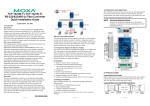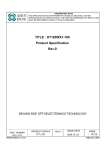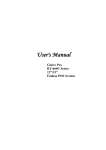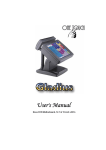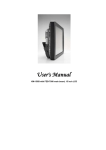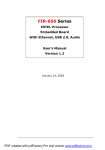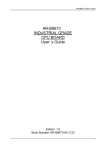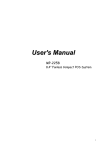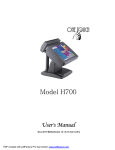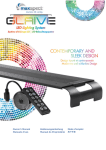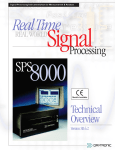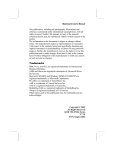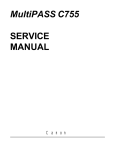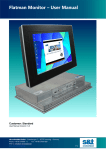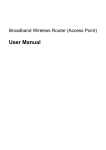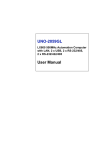Download Glaive Manual
Transcript
U s e r 's M a n u a l Glaive with FIR-C650 main board, 12.1 & 15 inch LCD’s Federal Communications Commission (FCC) This equipment has been tested and found to comply with the limits for a Class A digital device, pursuant to Part 15 of the FCC Rules. These limits are designed to provide reasonable protection against harmful interference in a residential installation. This equipment generates, uses, and can radiate radio frequency energy and, if not installed and used in accordance with the instructions, may cause harmful interference to radio communications. However, there is no guarantee that interference will not occur in a particular installation. If this equipment does cause harmful interference to radio or television reception, which can be determined by turning the equipment off and on, the user is encouraged to try to correct the interference by one or more of the following measures: Reorient or relocate the receiving antenna. Increase the separation between the equipment and the receiver. Connect the equipment to an outlet on a circuit different from that to which the receiver is connected. Consult the dealer or an experienced radio/TV technician for help. Shielded interconnect cables and shielded AC power cables must be employed with this equipment to insure compliance with the pertinent RF emission limits governing this device. Changes or modifications not expressly approved by the system’s manufacturer could void the user’s authority to operate the equipment. Declaration of Conformity This device complies with part 15 of the FCC Rules. Operation is subject to the following two conditions: 1. This device may not cause harmful interference, and 2. This device must accept any interference received, including interference that may cause undesired operation. Important Safety Information SAFETY INSTRUCTIONS 1. 2. 3. 4. 5. 6. 7. Please read these safety instructions carefully. Keep this User’s Manual for later reference. Don’t use liquid or spray detergent for cleaning. Use only a moistened sheet or cloth. For pluggable equipment, the socket-outlet should be installed near the equipment and should be easily accessible. Keep this equipment from extreme humidity areas. Lay this equipment on a stable surface when installing. Do not leave this equipment in a non-air conditioned environment, or in a storage temperature above 60∘C. Such conditions may damage the equipment. 10. Place the power cord so that it will not be stepped on. Do not place anything over the power cord. The power cord must be rated for the product and for the voltage and current marked on the product’s electrical ratings label. The voltage and current rating of the cord should be greater than the voltage and current rating marked on the product. 11. All cautions and warnings on the equipment should be noted. 12. If the equipment is not used for a long time, disconnect the equipment from the mains to avoid damage. 14. Never open the equipment. For safety reasons, qualified service personnel should only open the equipment. 15. If one of the following situations arises, get the equipment checked by service personnel: a. The Power cord or plug is damaged. b. Liquid has penetrated the equipment. c. The equipment has been exposed to extreme moisture conditions. d. The equipment does not work well or you cannot get it work according to the user’s manual. e. The Equipment has been dropped and damaged. f. The equipment has obvious signs of damage. Copyright The information in this guide is subject to change without prior notice. The manufacturer shall not be liable for technical or editorial errors or omissions contained herein, nor for incidental or consequential damages resulting from the furnishing, performance, or use of this material. This manual contains information protected by copyright. No part of this manual may be photocopied or reproduced in any form without prior written consent from the manufacturer. © 2004 All rights reserved. The software described in this guide is furnished under a license agreement or nondisclosure agreement. The software may be used or copied only in accordance with the terms of the agreement. Product names mentioned herein may be trademarks and/or registered trademarks of their respective companies. First Edition October 2004 Table of Content Chapter 1 Introduction 2 2 Glaive Characteristics .......................................................................................................... 2 How to Use This Manual...................................................................................................... 3 A Visual Tour of Glaive ........................................................................................................ 4 What comes with Glaive ............................................................................................... 5 Dimensions 12.1’’ ......................................................................................................... 6 Dimensions 15’’ ............................................................................................................ 6 Connector Panels ................................................................................................................ 7 Font Connector Panel ................................................................................................... 7 Rear Connector Panel .................................................................................................. 7 Chapter 2 Hardware Setup 8 8 Glaive Assembly .................................................................................................................. 8 Please make sure that the power supply is disconnected when making any hardware changes to Glaive. ........................................................................................................ 8 Hard Disk Drive Installation........................................................................................... 8 Compact Flash Installation.......................................................................................... 10 Magnetic Card Reader Installation .............................................................................. 11 MCR Parameter Modification ...................................................................................... 13 VFD Customer Display Installation.............................................................................. 14 Cash Drawer Installation............................................................................................. 16 CMOS Setup ..................................................................................................................... 16 Chapter 3 Software Setup 17 17 Operating System Installation ............................................................................................ 17 Windows 98 SE installation......................................................................................... 17 Windows 2K/XP installation ........................................................................................ 18 Device Driver Installation ................................................................................................... 19 VIA 4 in 1 Installation Utilities for Windows 98............................................................. 19 VIA 4 in 1 Installation Utilities for Windows 2000......................................................... 22 VIA 4 in 1 Installation Utilities for Windows XP............................................................ 24 VGA Driver Installation....................................................................................................... 27 VT8606 driver installation Windows 98 ....................................................................... 27 VT8606 driver installation Windows 2000 ................................................................... 28 LAN Driver Installation ....................................................................................................... 29 Realtek LAN Driver Installation Windows 98 ............................................................... 29 Realtek LAN Driver Installation Windows 2000 and Windows XP ............................... 31 Audio Driver Installation ..................................................................................................... 32 Audio Driver Installation for all Windows Operating Systems ...................................... 32 USB 2.0 Installation ........................................................................................................... 33 USB 2.0 Installation for Windows 98 Operating Systems ............................................ 33 USB 2.0 Installation for Windows 2000 and XP........................................................... 34 ELO Touch Tools Installation ............................................................................................. 35 ELO Touch Tools Installation for all Windows Operating Systems .............................. 35 ELO Control Panel...................................................................................................... 38 TouchKit Tools Installation................................................................................................. 41 TouchKit Tools Installation for all Windows Operating Systems .................................. 41 TouchKit Control Panel ............................................................................................... 44 Wireless LAN Driver Installation......................................................................................... 45 Wireless LAN Driver Installation for all Windows Operating Systems (Optional) ......... 45 Chapter 4 Specifications 46 46 MainBoard Configuration ................................................................................................... 48 I/O board Configuration...................................................................................................... 56 9000PB0610 I/O Board Pin Definition ......................................................................... 56 Chapter 5 Troubleshooting 59 59 Power is on, but there is no Panel Display .................................................................. 59 Cannot Detect HDD .................................................................................................... 60 Touch Panel Does not Work ....................................................................................... 60 ELO Touch Panel Cannot Calibrate Correctly ............................................................. 60 PS/2 Keyboard is not Functioning Normally ................................................................ 60 MCR is not Functioning Properly................................................................................. 61 VFD Display is not Functioning Properly ..................................................................... 61 LAN is not Functioning Properly.................................................................................. 61 COM1, COM2 are not Functioning Properly................................................................ 61 Cash Drawer Port is not Functioning Properly............................................................. 62 USB device is not Functioning Properly ...................................................................... 62 FIR-C650 Main Board Chapter 1 Introduction Glaive Characteristics • Glaive uses a high speed processor capable of handling a high capacity of data efficiently. • Glaive’s solid quality Aluminum housing distinguishes it from ordinary plastic housings. • The Glaive touch terminal all-in-one is a robust, fanless design and is suitable for a multitude of business types. • Glaive is very suitable to be used as a Thin Client in a networked environment. • The LCD panel can be tilted at multiple angles for operator ease of use. • Glaive’s functionality extends far beyond the standard setup. Glaive can be adapted for a variety of uses with the addition of any of the following options: Magnetic Card Reader, VFD/LCD customer display and Cashdrawer, Hard disk, Modem, LAN, Audio devices, Compact Flash, Camera, Biometric reader and a wide variety of USB devices (all available upon request). • Glaive’s security is designed to prevent data theft. The Glaive system can be totally diskless or may be equipped with an internal 2.5” HDD. Data Backup can be constrained to Backup Servers in a network environment, or to (optional) removable external Storage devices making it hard to copy data without authority. • Glaive is a fanless solution, which utilizes the solid aluminum housing to dissipate any excess heat. • Additionally the aluminum casing also assures compliance to vigorous EMI radiation testing. 2 FIR-C650 Main Board How to Use This Manual This manual contains all the information you need to set up and use Glaive. In addition, you can also consult the manuals for the operating system and any additional hardware manuals for peripherals that you may have added. Chapter 1 Provides an introduction to Glaive and this manual. Chapter 2 Provides all necessary information for all hardware setup. Chapter 3 Provides the necessary information for installing the video drivers, touch screen tools, audio, USB and LAN drivers. Chapter 4 Lists all Glaive specifications and Information for the mainboard configuration. Chapter 5 Provides information for troubleshooting the Glaive. 3 FIR-C650 Main Board A Visual Tour of Glaive Before you start, take a few moments to become familiar with Glaive. 12” Glaive 15” Glaive 4 FIR-C650 Main Board What comes with Glaive The following items are standard with Glaive: The following items are optional: • Magnetic Card Reader (MCR) and bracket Power adapter • VFD customer display • User’s guide • Wireless LAN • FIR-C650 motherboard user’s guide • Hard Disk Drive • ELO touch screen driver CD • Motherboard chipset driver CD • AC power cord • Main system with LCD panel • Glaive with MCR Glaive with VFD 5 FIR-C650 Main Board Dimensions 12.1’’ Glaive Dimensions Glaive and VFD customer display Dimensions 15’’ Glaive Dimensions 6 FIR-C650 Main Board Connector Panels Font Connector Panel The Font connector panel is located at the bottom of the main unit base. USB 2 USB 3 VGA K/B POWER ON/OFF I/O Port Connector Type Description USB 2 & 3 USB Type A VGA VGA Connector KBD PS/2 Keyboard Connector Tactile Switch These are USB version 2.0 ports and can be used to connect most USB devices. The VGA port is for use with an external LCD or CRT monitor. The KBD port for an external keyboard. Power Switch ATX power switch function. Rear Connector Panel The Second connector panel is located on left side of the back of the main unit. It comes with a cover that needs to be removed to install a CD ROM Driver or a VGA monitor. LINE OUT USB 1 CASH DRAWER MIC COM 1 LAN COM 2 COM 4 DC+12 I/O Port Connector Type Description Power Cash Drawer Line Out LAN DC Power Connector RJ11 Connector COM1 COM2 DSUB Connector COM4 VFD/ COM4 RJ45 Connector Connects Glaive to the power supply. Cash Drawer Connector, 12 V Actuation support for solenoid. The audio port is for speakers. The LAN port is used to hook Glaive to a local area network. The serial ports COM1/COM2 can be used to connect serial devices such as a mouse or a fax/modem. This RJ45 port is used to attach a VFD customer display or may be used as an additional serial port. USB 1 USB A Connector This is a USB version 1.1 for additional devices Earphone Connector LAN RJ45 Connector 7 FIR-C650 Main Board Chapter 2 Hardware Setup Glaive Assembly Please make sure that the power supply is disconnected when making any hardware changes to Glaive. Hard Disk Drive Installation A standard Glaive comes without a hard disk drive (HDD), unless it is pre-requested. Installing a HDD 1. Turn off power and remove power cable from main unit. 2. Remove 4 screws and slightly separate the LCD front frame from the rear housing. 8 FIR-C650 Main Board 3. Unplug the JCS1 cable from the 9000PB0610 I/O board. 4. Lay the LCD face down on a flat surface and use the 4 screws provided to mount the HDD into the bracketed space. 5. Connect the existing 44pin ribbon cable to the HHD 6. Reconnect the JCS1 cable to the 9000PB0610 I/O board 7. Reassemble the LCD front frame and rear housing and secure with 4 screws. 8. Connect the main unit power. Note: If the HDD does not work normally, please refer to troubleshooting 9 FIR-C650 Main Board Compact Flash Installation Glaive will configure Compact Flash in IDE mode as secondary master after it is installed. The next available drive letter will be automatically assigned to Compact Flash. Installing Compact Flash 1. Turn off power and remove power cable from Glaive. 2. As the compact Flash socket is located internally, position Glaive to expose the underside and unscrew the single retaining screw and remove the bottom cover plate. 3. Insert the Compact Flash as shown in the picture. 4. Replace the bottom cover plate and secure with the single screw. 5. Connect the main unit power and power the unit on. 6. The Compact Flash will automatically appear as the next available IDE drive 10 FIR-C650 Main Board Magnetic Card Reader Installation An optional Magnetic Card Reader (MCR) can be installed on the right side of the Glaive. Magnetic Card Reader (MCR) Installing an MCR 1. Turn off system power. 2. Unplug the loopback from the MCR socket. The MCR socket is found on the right side on the back of the main Unit. 3. Connect the MCR cable to the MCR socket. 11 FIR-C650 Main Board 4. Secure the MCR to the main unit with 2 screws. 5. Turn on system power. Note: If the MCR does not work normally, please refer to troubleshooting. Attention: The loopback or the MCR cable must be inserted in the socket for an external keyboard to function with Glaive. 12 FIR-C650 Main Board MCR Parameter Modification This option is for users who need to customize the MCR parameters for a particular task. Some of the useful parameters include: The selection of country code, other than the default English. The choice of track combinations. The preamble/postamble codes. The MCR parameters can be modified by using the supplied utility program. The utility can be found on the CD that came with your system in the “Utilities” folder. The program name is msr_v12_win.zip. If you are upgrading and earlier system to include our MCR reader, then this utility can be located on our website at http://www.firich.com.tw/tech_drivers.htm in the section labeled as “MSR Utility”. Unzip this file onto your system hard disk, in a folder of your choice. It will also create 3 subfolders named Disk1, Disk2, and Disk3. Change to the folder “Disk1” and run the “Setup.exe” program, and follow the simple onscreen instructions. When the installation finishes, you will find that a new folder has been created in your “Program files” folder, labeled as “Decoder” with a subfolder named “S64 Decoder”. Now change folder to C:\Program Files\Decoder\S64 Decoder and run the program named “S64_cfg.exe”. When the program has loaded please select the Magnic_Reader menu item as in the following picture. By using the 3 top items listed; Interface, Communication and Miscellaneous, you will be able to alter many of the parameters associated with the MCR unit. When you have finished your modifications and are sure that they are set exactly how you want them to be, just click on the menu item Transmit to download the new parameter to the MCR unit. Please refer to the Help menu for any further assistance. 13 FIR-C650 Main Board VFD Customer Display Installation An optional VFD customer display can be installed on the back of Glaive. Rear view with VFD attached. Installing a VFD 1. Turn off system power. 2. Make sure that JP4 and JP5 on the M/B are set correctly. It is important to note that the supply voltage for the customer display has been set to +12V, which is for VFD type. If an LCD customer display is chosen, please change it to +5V through JP4 on M/B. Please refer to page 50 of FIR-C650 motherboard manual COM4 Voltage selection and COM4 mode selection. 3. Remove the VFD Mounting Cover from the base. 4. Secure the VFD Holder to the base with 3 screws and place VFD display into the holder. 14 FIR-C650 Main Board 5. Connect the VFD RJ45 cable in the VFD/COM4 port on the I/O panel which is located under the base. 6. Turn on VFD power switch, then turn on system power. Note: If the VFD does not display correctly after an application is loaded, please refer to troubleshooting. 15 FIR-C650 Main Board Cash Drawer Installation Before connecting the cash drawer to the Glaive, please make sure the drive voltage and cable pin assignment of the cash drawer matches the definition of the cash drawer port of Glaive. Please refer to page 54 in the motherboard manual for more information on the Cash Drawer. Plug cash drawer cable into cash drawer port. Note: If the cash drawer cannot be detected by the system, please refer to troubleshooting. Up to two cash drawers may be driven from this port. Driving voltage of the solenoid is DC+12V. I/O port 280h is used for drawer operation. A test program is supplied, for Linux and Windows, source code of which is available on request by software developers. Hardware logic is as follows. To open drawer1, write 01h to port 280h, wait 200 msec, then write 00h to turn off the drive. To open drawer2, write 02h to port 280h, wait 200 msec, then write 00h to turn off the drive. To test for drawer open, read port 280h, if bit 0=1 then drawer is open, if bit 0=0 drawer is closed. CMOS Setup Please refer to the FIR-C650 M/B User's Manual Chapter 4 for a detailed description of the BIOS CMOS setup. 16 FIR-C650 Main Board Chapter 3 Software Setup Operating System Installation Glaive units are widely used as networked Thin Client terminals and as such do not have an internal hard disk drive. This is our factory default. However, users can upgrade Glaive later by adding their own hard disk drive. Similarly the unit may have been ordered and delivered with a hard disk drive installed. And unless the unit has also been pre-installed with an operating system, then one will have to be installed. Windows 98 SE installation As it is not possible to attach an IDE CDROM drive to the Glaive unit, installing Windows 98 SE may appear to be difficult. There are a number of ways in which Windows 98 SE can be installed. This is probably the easiest method. This objective is to create a bootable MSDOS Compact Flash that will include all the required Windows 98 setup files. Items required: A PC or Notebook computer equipped with a CDROM drive, a Compact Flash reader/writer device, a 128MB or 256MB Compact Flash, a floppy disk drive with an MSDOS boot diskette that also contains the DOS system utilities “Fdisk” and “Format” programs. * Real-mode CD-ROM drivers You will need real-mode CD-ROM drivers loaded so you can access the Windows 98 Second Edition CD. If you have ever run Windows 98 SE Setup before and have created a Startup Disk, you can boot and use the CD-ROM drivers included on that disk. If you do not have a Startup Disk, you will need to run the installation program that came with your CD-ROM hardware. 1. Boot the PC or Notebook from the Floppy diskette 2. Insert the 128MB or 256MB Compact Flash into the reader/writer device 3. Use the Format program to format the Compact Flash as a “bootable” FAT16 volume 4. Copy all files from the floppy to the Compact Flash 5. Create a folder called "W98Flat" on the Compact Flash drive (to create a folder, switch to the Compact Flash drive letter and type: MD W98Flat 6. Now, switch to the Windows 98 Second Edition CD-ROM drive and to the Win98 directory 7. Then copy the Windows 98 Second Edition Setup files to the folder you just created on the Compact Flash by typing: Copy *.* < Compact Flash drive letter>\W98Flat 8. After all the files are copied, you may now remove the Compact Flash from the PC 17 FIR-C650 Main Board 9. Insert the Compact Flash into the Glaive (follow instructions earlier in this manual) 10. Modify CMOS BIOS to Boot from Compact Flash 11. Power on the system and the unit should boot MSDOS from the Compact Flash drive 12. At the MSDOS prompt, type FDISK and partition the Hard Disk drive as required 13. After partitioning is complete, Format the Hard Disk drive 14. At the MS DOS prompt change directory to W98Flat 15. Type Setup and press Enter 16. Follow the onscreen instructions for normal installation of Windows 98 SE Windows 2K/XP installation Installing Windows 2K or XP can be performed on the Glaive quite simply Items required: A USB CDROM drive 1. Attach the USB CDROM drive to Glaive. 2. In the CMOS setup “Advanced Chipset setup” change the item “USB Device Legacy Support” to “All Devices” this will allow booting from any USB bootable device. 3. Power on and modify CMOS BIOS settings to enable the USB CDROM to be the first bootable device (see CMOS setup in the motherboard manual) 4. Insert the 2K or XP CDROM disk into the drive 5. Reboot the system 6. The Glaive will boot from CDROM drive and automatically start the setup programs 7. Follow the onscreen instructions for normal installation of 2K or XP 18 FIR-C650 Main Board Device Driver Installation Glaive comes with a variety of drivers for different operating systems. You will find 1 CD with Glaive. The CD has all the necessary drivers to setup Glaive. VIA 4 in 1 Installation Utilities for Windows 98 1. Locate D:\4in1 folder 2. Run Setup.exe 3. Click Next 4. Click Yes 19 FIR-C650 Main Board 5. Click Next 6. Click Next 7. Click Next 20 FIR-C650 Main Board 8. Click Next 9. Click Next 10. Click Next 21 FIR-C650 Main Board 11. Click Finish VIA 4 in 1 Installation Utilities for Windows 2000 1. Locate D:\4in1 folder 2. Run Setup.exe 3. Click Next 4. Click Yes 22 FIR-C650 Main Board 5. Click Next 6. Click Next 7. Click Next 23 FIR-C650 Main Board 8. Click Next 9. Click Finish VIA 4 in 1 Installation Utilities for Windows XP 1. Locate D:\4in1 folder 2. Run Setup.exe 3. Click Next 24 FIR-C650 Main Board 4. Click Yes 5. Click Next 6. Click Next 25 FIR-C650 Main Board 7. Click Next 8. Click Finish 26 FIR-C650 Main Board VGA Driver Installation VT8606 driver installation Windows 98 1. Locate the VGA folder on the utilities CD. 2. Open D:\VGA\VIA\Twister\Win9x folder 3. Run Setup.exe. 4. Select Next to continue 5. Select Next to continue. 6. Click Finish to complete the installation procedure and restart Glaive. 27 FIR-C650 Main Board VT8606 driver installation Windows 2000 1. Open D:\VGA\VIA\ Twister\WIN2K&XP folder. 2. Run Setup.exe. 3. Select Next to continue. 4. Select Next to continue. 5. Click Finish to complete the installation procedure and restart Glaive. 28 FIR-C650 Main Board LAN Driver Installation Realtek LAN Driver Installation Windows 98 1. Open Device Manger in the System Properties. Select PCI Ethernet Controller Click Properties 2. Select the Driver tab. Click Update Driver. 29 FIR-C650 Main Board 3. Click Next. 4. Select Search for a better driver then the one your device is using now (Recommended). Click Next. 5. Select Specify a location: Click Browse. Open D:\LAN\REALTEK\8139C\WIN98 Click Next. 30 FIR-C650 Main Board 6. Click Next. 7. Click Finish. 8. Click Yes to restart your computer. Realtek LAN Driver Installation Windows 2000 and Windows XP After Windows 2000 is installed the Realtek LAN driver will be automatically installed. 31 FIR-C650 Main Board Audio Driver Installation Audio Driver Installation for all Windows Operating Systems 1. Open D:\AUDIO\VIA\686A_B 2. Run SETUP.EXE 3. Click Next 4. Click Next 5. Click Finish 32 FIR-C650 Main Board USB 2.0 Installation USB 2.0 Installation for Windows 98 Operating Systems 1. Open D: \USB20\VIA 2. Run Setup.exe 3. Click Next 4. Click Next 5. Click Finish 33 FIR-C650 Main Board USB 2.0 Installation for Windows 2000 and XP For Windows 2000, SP4 must be installed for USB 2.0 support. For Windows XP, SP1 or SP2 must be installed for USB 2.0 support. Note, with lower version service packs only USB 1.1 is supported. This will be indicated in the device manager as an exclamation icon (!) beside the USB device. Following service pack upgrade, it is NOT necessary to install the VIA USB 2.0 driver. 34 FIR-C650 Main Board ELO Touch Tools Installation ELO Touch Tools Installation for all Windows Operating Systems 1. Locate D:\TOUCHSCREEN\ELO Touch 2. Select the relevant ELO folder for the operating system that you are using. Example. If you are installing for a Windows 98 system, then select Elo Win9x_Me. If you are installing under Windows 2000 or XP then select Elo Touch 2K_XP 3. Run Setup.exe 4. Click Next 5. Check “Install serial Touch screen Drivers.” And Click Next. 6. Read the “License Agreement” and click Yes if you accept it. 35 FIR-C650 Main Board 7. Select “Auto-detect Elo devices.” and click Next. 8. Select the COM port for the touch monitor. It is recommended that you select COM3 for the touch screen, as this port is internally configured for touch operation. 9. Wait until the ELO Touch Tools have been installed. 36 FIR-C650 Main Board 10. Select View ELO touch screen control panel and click Finish. IT MAY BE NECESSARY TO RESTART YOUR COMPUTER TO UTILIZE YOUR TOUCHSCREEN FEATURES. 11. Click NEXT while this window appears after system finishs rebooting. 12. Click YES to restart your computer again. After the system finishes rebooting follow the directions to calibrate ELO Touch Tools. 37 FIR-C650 Main Board ELO Control Panel This section explains the different options in the ELO control Panel. General tab The general tab allows you to: • Change the COM port your touch screen is set to. • Calibrate the touch screen with the Align button. 38 FIR-C650 Main Board Mode tab The Buttons tab allows you to: • Adjust all mouse emulation controls. • Change cursor properties • Enable or disable right mouse button utility. Sound tab The Sound tab allows you to: • To change sound properties for ELO touch tools. 39 FIR-C650 Main Board Properties tab The Diagnostics tab allows you to: • View Controller Information. About tab The About tab displays Information about ELO Touchsystems 40 FIR-C650 Main Board TouchKit Tools Installation TouchKit Tools Installation for all Windows Operating Systems 1. Locate D:\TOUCHSCREEN\eGalax Touch\Driver 2. Select the relevant eGalax folder for the operating system that you are using. Example. If you are installing for a Windows 98 system, then select Win9x_Me. If you are installing under Windows 2000 or XP then select Win2000_XP 3. Run Setup.exe 4. Click Next 5. Click Next 41 FIR-C650 Main Board 6. Click Next 7. Click Next 8. Click Next 42 FIR-C650 Main Board 9. Click Yes 10. Click Finish to restart your computer again. After the system finishes rebooting follow the directions to calibrate the Touch screen. 43 FIR-C650 Main Board TouchKit Control Panel This section explains the different options in the TouchKit control Panel. General tab The general tab allows you to: • Change the COM port your touch screen is set to. • Calibrate the touch screen with the 4 pts Cal button. 44 FIR-C650 Main Board Wireless LAN Driver Installation Wireless LAN Driver Installation for all Windows Operating Systems (Optional) 1. Open D:\Wireless LAN folder 2. Run Setup.EXE 3. Click Next 4. Click Next 45 FIR-C650 Main Board Chapter 4 Specifications System Configuration CPU Chipset DRAM Primary SVGA Primary LCD Panel Primary Touch Panel Compact Flash Disk socket Power Intel® Ultra Low Voltage Celeron 400MHz VIA® VT8606 (Integrated 2D/3D graphics accelerator) & VT82C686B. One 144-pin SO-DIMM socket. Maximum memory is 512MB. AGP On chip VT8606 (Share memory up to 32MB RAM) for primary LCD panel. 12” TFT LCD Panel (800X600) or 15” TFT LCD Panel (1024X768) ELO 5-wire resistive touch panel or 4-wire resistive touch panel Type II Compact Flash™ Disk. The Flash Disk provides 100% compatibility with IDE hard disk. 62-Watt external power adapter. I/O Port Serial Port Cash drawer port Keyboard Port LAN Port 2 User available Com ports (COM1 & COM2). 2 System assigned Com ports (COM3 & COM4). COM3 for primary touch screen. COM4 for customer character display. Supports 1 x USB V1.1 port, 2 x USB2.0 ports for user expansion Two internal USB 2.0 ports reserved for Wireless LAN and IC Card reader. RJ11 Single/Dual Cashdrawer port, 12V actuation support. One PS/2 keyboard port. 10/100Mbps Ethernet Controller Realtek RTL8100BL. VGA Port Standard VGA Port. Audio Port Integrated VT1612A PCI, Sound Blaster compatible, AC97. USB port Construction Injection-Molded, Die-cast aluminum enclosure, spill resistance. 46 FIR-C650 Main Board Optional Features Customer display Magnetic card reader FDD HDD KB-32 Integrated VFD/LCD customer display. Integrated Single/Dual/Triple Track MCR. External USB Floppy disk drive. Internal 2.5” 30GB (or above) hard disk drive. 32 Key programmable keypad w/wo Dallas ID keyfob pad. Power Consumption 20-30W Idle (Standard system and accessing HDD) 47 FIR-C650 Main Board MainBoard Configuration 48 FIR-C650 Main Board This chapter describes how to connect peripherals, switches and indicators to the FIR-C650 board. Label LVDS1 VGA1 LAN1 USB1 USB2 COM1 COM2 COM4 KB_MS1 KB1 SPK_OUT1 MIC_IN1 IDE1 CF1 PS_ON1 LED1 CN1 CN2 CN3 CN4 CN5 CN6 CN7 JP1 LVDS LCD Panel connector VGA connector LAN RJ45 connector USB 2.0 dual port connector USB 1.1 port connector Serial port connectors Serial port connectors Serial port connectors Keyboard & Mouse connector Internal Keyboard connector Speaker out connector MIC in connector Ultra ATA100 Primary IDE connectors Compact Flash Storage Card Type II connector Power on Switch Power LED Digital I/O connector +12V DC power connector External switches and indicators LVDS back light connector Multi-function connector Line out connector Power output connector Clear CMOS Setup JP1 Short 1-2 (default)* Short 2-3 JP3 Function Description Keep CMOS Setup (Normal Operation) Clear CMOS Setup TFT LCD Voltage ( 5V / 3V ) Setting JP3 Short 1–2 Short 2–3 Description 3V TFT LCD 5V TFT LCD 49 FIR-C650 Main Board JP4 COM4 Voltage Selection JP4 Short 1-2 Short 2-4 JP5 COM4 Mode Selection JP5 Short 1-2 Short 3-5 Short 4-6 JP6 Description RI is +5Volt output RI function RI is +12 Volt output COM1 RI Function Setting JP7 Short 1-2 Short 3-4 Short 5-6 LVDS1 Description Short CTS-RTS +12/+5V output Ground output COM2 RI Function Setting JP6 Short 1-2 Short 3-4 Short 5-6 JP7 Description +12V +5V Description RI is +5 Volt output RI function RI is +12 Volt output LVDS Function Setting PIN No. 1 3 5 7 9 11 13 15 17 19 Description PIN No. LCD (+3V or +5V) LVDS data0 output GROUND LVDS data1 output GROUND LVDS data2 output GROUND LVDS clock output GROUND LVDS data3 output - 2 4 6 8 10 12 14 16 18 20 50 Description LCD (+3V or +5V) LVDS data0 output + GROUND LVDS data1 output + GROUND LVDS data2 output + GROUND LVDS clock output + GROUND LVDS data3 output + FIR-C650 Main Board VGA1 15 Pin Female Connector PIN 1 3 5 7 9 11 13 15 LAN1 Description GREEN NC GROUND GROUND GROUND DDC DAT VSYNC Description TX+ TXRX+ N/C N/C RX- PIN 7 8 9 10 11 12 Description N/C N/C Speed + Speed Active/LINK + Active/LINK - PIN 5 6 7 8 Description VCC DATA1DATA1+ GROUND PIN 2 4 Description DATAGROUND 2 Ports USB Connect (USB 2.0) PIN 1 2 3 4 USB2 PIN 2 4 6 8 10 12 14 RJ45 Connectors (10 / 100M ) PIN 1 2 3 4 5 6 USB1 Description RED BLUE GROUND GROUND VCC / NC NC HSYNC DDCCLK Description VCC DATA0DATA0+ GROUND 1 Ports USB Connect (USB 1.1) PIN 1 3 Description VCC DATA0+ 51 FIR-C650 Main Board COM1 D-SUB Serial Port Connector PIN 1 2 3 4 5 COM2 PIN 6 7 8 9 Description DSR RTS CTS RI PIN 6 7 8 9 Description DSR RTS CTS RI PIN 2 4 6 8 Description +12/+5V or CTS GROUND or RTS DSR RXD D-SUB Serial Port Connector PIN 1 2 3 4 5 COM4 Description DCD RXD TXD DTR GROUND RJ-45 Serial Port Connector PIN 1 3 5 7 KB_MS1 Description +12/+5V GROUND DTR TXD Mini DIN Keyboard / Mouse Connector PIN 1 2 3 4 5 6 KB1 Description DCD RXD TXD DTR GROUND Description KEYBOARD DATA MOUSE DATA GROUND +5V KEYBOARD CLOCK MOUSE CLOCK 6 Pin Keyboard Connector PIN 1 2 3 4 5 6 Description +5V KEYBOARD CLOCK PC KB CLOCK KEYBOARD DATA PC KB DATA GROUND 52 FIR-C650 Main Board SPK_OUT1 PIN 1 3 MIC_IN1 Description NC Line Out (Left) PIN 2 4 Description GROUND Speaker Out (Right) PIN 2 4 Description GROUND NC PIN 2 4 6 8 10 12 14 16 18 20 22 24 26 28 30 32 34 36 38 40 42 44 Description GROUND DATA 8 DATA 9 DATA 10 DATA 11 DATA 12 DATA 13 DATA 14 DATA 15 N/C GROUND GROUND GROUND REV. PULL LOW GROUND N/C PD66 SELECT SA2 HDC CS1# GROUND +5V N/C Microphone in Connector PIN 1 3 IDE1 Speaker out Connector Description NC MIC In IDE Interface connector PIN 1 3 5 7 9 11 13 15 17 19 21 23 25 27 29 31 33 35 37 39 41 43 Description RESET# DATA 7 DATA 6 DATA 5 DATA 4 DATA 3 DATA 2 DATA 1 DATA 0 GROUND DRQ IOW# IOR# CHRDY DACK INTERRUPT SA1 SA0 HDC CS0# HDD ACTIVE# +5V GND 53 FIR-C650 Main Board CF1 Compact Flash Storage Card Socket pin assignment PIN 1 2 3 4 5 6 7 8 9 10 11 12 13 14 15 16 17 18 19 20 21 22 23 24 25 CN1 PULL DOWN PIN 26 27 28 29 30 31 32 33 34 35 36 37 38 39 40 41 42 43 44 45 46 47 48 49 50 Description PULL DOWN D11 D12 D13 D14 D15 CS3# N/C IOR# IOW# VCC IRQ15 VCC MASTER/SLAVE N/C RESET# IORDY N/C VCC ACTIVE# PDIAG# D8 D9 D10 GROUND DGI/O Connector PIN 1 3 5 CN2 Description GROUND D3 D4 D5 D6 D7 CS1# N/C GROUND N/C N/C N/C VCC N/C N/C N/C N/C A2 A1 A0 D0 D1 D2 N/C Description GROUND DGI/O IN 0 DGI/O OUT 1 PIN 2 4 6 Description DGI/O OUT 0 +12V GROUND PIN 2 4 Description GROUND GROUND +12V DC Power Connector PIN 1 3 Description +12V +12V 54 FIR-C650 Main Board CN4 LCD Back Light Connector PIN 1 3 5 CN5 Description +12V GROUND Description +5V USB- (USB2.0) USB+ (USB2.0) GROUND DTR RTS RX PIN 2 4 6 8 10 12 14 Description +5V USB- (USB2.0) USB+ (USB2.0) GROUND CTS TX DSR PIN 2 4 Description GROUND GROUND PIN 2 4 Description GROUND +5V Line out connector PIN 1 3 CN7 PIN 2 4 Multi-function connector ( USB 2.0 and COM3 ) PIN 1 3 5 7 9 11 13 CN6 Description +12V GROUND Back Light enable Description LINE Out (Left) LINE Out (Right) Power output connector PIN 1 3 Description +12V GROUND 55 FIR-C650 Main Board I/O board Configuration The 9000CB0610 board carries the following signals to the mainboard. Including: LCD, inverter, COM3, Keyboard and two USB port. 9000PB0610 I/O Board Pin Definition MCR + IC CARD USB 1 1 1 Inverter CON 2 CON 1 9000CB0610 CON 4 JCS1 JP 1 1 19 CON 5 1 36 LVDS JCS1 Multi Signal connector PIN No. Description PIN No. 1 2 3 4 5 6 7 8 9 10 11 12 13 14 15 16 17 18 XN XP USB1 DATAGND PVDD RX0RX1RX2RXCLKRX3GND USB2 DATAGND KB-CLK KB-DATA GND +12V GND 19 20 21 22 23 24 25 26 27 28 29 30 31 32 33 34 35 36 56 Description YP YN +5V USB1 DATA+ PVDD RX0+ RX1+ RX2+ RXCLK+ RX3+ GND VCC USB2 DATA+ VCC PC-CLK PC-DATA +12V Back Light Enable COM 3 1 FIR-C650 Main Board CON1 K/B Wedge MCR/USB connector PIN No. 1 2 3 4 5 6 7 8 CON2 USB connector PIN No. 1 2 3 4 CON4 Description VDD DATADATA+ GND LCD Back Light connector PIN No. 1 2 3 4 5 CON5 Description USB DATA+ GND DC- DATA KB- DATA PC-CLK KB-CLK VDD USB DATA- Description DC+12V DC+12V Back Light Enable GND GND LVDS connector PIN No. 1 2 3 4 5 6 7 8 9 10 Description PVDD PVDD GND GND RX0RX0+ GND RX1RX1+ GND PIN No. 11 12 13 14 15 16 17 18 19 20 57 Description RX2RX2+ GND RXCLKRXCLK+ GND RX3RX3+ GND GND FIR-C650 Main Board CON6 RS232 connector PIN No. 1 2 3 4 5 6 DESCRIPTION GND TX RTX RS DSR +5V 58 FIR-C650 Main Board Chapter 5 Troubleshooting Please note that the following troubleshooting guide is designed for people with strong computer hardware knowledge such as System Administrators and Engineers. Power is on, but there is no Panel Display A) Check that the mainboard Power LED is on when the power adapter power switch is in the on position. Ensure that the correct AC voltage is selected (the voltage switch is located beside the power switch). B) Check that the Power are running when system power is on. B-1) Check whether the ATX power switch cable is properly connected to mainboard CN2 (Please refer to page7 in the FIR-C650 User’s guide). C) Please ensure that the IDE cable is properly connected to the HDD and the red stripe on the ribbon cable should align with IDE1 on the IDE connector of HDD. D) Reset CMOS DATA by shorting mainboard JP1 PIN2 and PIN3 for a few seconds (Please refer to page49 in the FIR-C650 User’s guide). E) Check if the system is beeping. E-1) A single long repeated beep indicates that a DRAM error has occurred. Make sure DRAM is properly installed or replace DRAM. E-2) One short beep after power on, means system is ok, but LCD panel or VGA interface could be defective. E-2-1) INIT display should be set for AGP in the COMS setup. E-2-2) LVDS board connection to mainboard LVDS1 could be defective. E-2-3) The connection between the LVDS board and the LCD panel connector not connected properly. E-2-4) The LCD cable could be defective. E-2-5) The Inverter cannot produce backlight. E-2-6) The LCD panel could be defective. To check where the problem could be: Please connect a VGA monitor to the VGA port. If the VGA monitor is display normally, one of the problems above is occurring, otherwise it could be the mainboard is not functioning properly. 59 FIR-C650 Main Board Cannot Detect HDD A) IDE cable is not connected properly to mainboard IDE1 or it could be defective. B) HDD power cable is not connected properly to the I/O board or it could be defective. C) Check CMOS setup, set IDE HDD to Auto detects. D) On-board IDE port could be defective. Touch Panel Does not Work A) Check CMOS settings, COM3 needs to be “Enabled”. The correct settings are “3E8h” and “IRQ10”. B) Check that there are no conflicts between COM3 IRQ10 and any other devices. C) Check that the ELO driver or the TouchKit driver has been properly installed. Or try to reinstall again (Please refer to the ELO driver installation or the TouchKit driver). D) Check that the ELO controller or the TouchKit driver on COM3 has been detected during the ELO driver or the TouchKit driver installation. If yes, than check that the flat cable from the ELO touch screen or the TOUCHKIT touch screen has been properly connected to the ELO controller or the TouchKit controller (Attention: Pin1 mark should be on the same side as the ELO controller). E) Check that the ELO controller or the TouchKit controller Green LED is blinking? If no, there is no DC+5V support for the ELO controller or the TouchKit controller from the mainboard. E-1) F) Check that the COM3 cable is properly connected between mainboard CN5 and the Touch screen controller. Touch screen controller could be defective or the touch panel could be defective. ELO Touch Panel Cannot Calibrate Correctly A) Please replace the ELO controller, and re-calibrate. If this works, change back to the original ELO controller, and re-calibrate. B) If the ELO touch panel still cannot calibrate correctly after changing to a new ELO controller, the touch panel may be not installed properly or it could be defective. PS/2 Keyboard is not Functioning Normally A) Make sure the keyboard is properly connected to the PS/2 keyboard port before the system is powered up. If the keyboard is connected after Windows2000 has been booted, the keyboard will not work. B) Check that the LED on the keyboard goes on then off after power on. If yes, the keyboard is getting power correctly. C) If the MCR is not required. Please make sure the loopback is plugged into the MCR connector board. D) Check that the 6-wire cable has been properly connected between the MCR connector board and mainboard KB1 The mainboard KB1 cable can be removed. Then short Pins 2-3 and Pins 4-5 If the keyboard still does not work, then check next step. Otherwise, the cable or MCR 60 FIR-C650 Main Board connector board could be defective. E) The mainboard could be defective. MCR is not Functioning Properly A) B) Check if the green MCR LED is on. A-1) Check if the MCR is properly connected to the MCR connector board on main system. A-2) Make sure the 6 wire cable is properly connected between 9000PB0610 I/O board CN20 and the MCR connector board. A-3) The MCR connector board could be defective. A-4) The MCR module could be defective. If a keyboard is connected to the PS/2 keyboard port, and functions correctly, then the MCR module could be defective. VFD Display is not Functioning Properly A) Ensure that COM4 is enabled in the CMOS setup, and data is written to COM4 in the application. B) Check if there is any display when system power is ON, if the screen is blank, please follow the steps below. B-1) Make sure the power switch on the VFD display is on before powering the main system. B-2) Make sure that the mainboard JP4 & JP5 jumper settings are correct. The proper settings are: JP4 Pins 1-2 shorted JP5 Pins 1-2, Pins 3-5 and Pins 4-6 shorted C) The on-board COM4 I/O chips could be defective. LAN is not Functioning Properly A) Check if the LAN driver is installed properly. (Please refer to the LAN driver installation) B) Check if there are any IRQ conflicts. C) Check if the RJ45 cable is properly connected. D) The on board LAN chip could be defective. COM1, COM2 are not Functioning Properly A) Check if the I/O ports are enabled in the CMOS setup. B) Check if there are any IRQ conflicts. C) The mainboard could be defective. 61 FIR-C650 Main Board Cash Drawer Port is not Functioning Properly A) Make sure the pin assignment matches between the cash drawer and the RJ11 cash drawer port. B) Verify the digit I/O port address and bit are “280h” respectively. Command send “L” level for 200ms (Refer to FIR-C650 user’s manual page 54). C) The mainboard could be defective. USB device is not Functioning Properly A) Ensure that the USB controller is “enabled” in the CMOS setup. B) Ensure that the USB Legacy is “enabled” in the CMOS setup. (Windows 98、Windows 2000、Window XP Professional) C) Ensure that the USB Legacy is “Disabled” in the CMOS setup. (Embedded OS: Windows XP Embedded、Window CE. NET、Linux RedHat 9) 62



































































